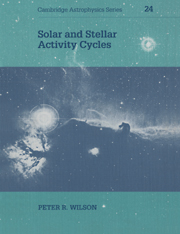Book contents
- Frontmatter
- Contents
- Preface
- Acknowledgments
- 1 Introduction
- 2 Historical survey
- 3 The structure of the Sun and the phenomena of activity
- 4 The equations of magnetohydrodynamics and magnetohydrostatics
- 5 The one-dimensional configuration of the cycle
- 6 Heuristic models of the solar activity cycle
- 7 Stellar activity and activity cycles
- 8 The two-dimensional representation of the extended activity cycle
- 9 The origin of the large-scale fields
- 10 The reversal of the polar magnetic fields
- 11 The role of dynamo theory in cyclic activity
- 12 Helioseismology and the solar cycle
- 13 Cyclic activity and chaos
- 14 Forecasting the solar cycle
- 15 Summary and conclusions
- Author index
- Subject index
3 - The structure of the Sun and the phenomena of activity
Published online by Cambridge University Press: 27 October 2009
- Frontmatter
- Contents
- Preface
- Acknowledgments
- 1 Introduction
- 2 Historical survey
- 3 The structure of the Sun and the phenomena of activity
- 4 The equations of magnetohydrodynamics and magnetohydrostatics
- 5 The one-dimensional configuration of the cycle
- 6 Heuristic models of the solar activity cycle
- 7 Stellar activity and activity cycles
- 8 The two-dimensional representation of the extended activity cycle
- 9 The origin of the large-scale fields
- 10 The reversal of the polar magnetic fields
- 11 The role of dynamo theory in cyclic activity
- 12 Helioseismology and the solar cycle
- 13 Cyclic activity and chaos
- 14 Forecasting the solar cycle
- 15 Summary and conclusions
- Author index
- Subject index
Summary
Far out in the uncharted waters of the unfashionable end of the western spiral arm of the Galaxy lies a small, unregarded, yellow sun.
D. Adams, The Hitch-hikers Guide to the GalaxyO Sole Mio
Neapolitan folk songBasic data
The historical studies traced in the previous chapter provided an introduction to our knowledge of the structure of the Sun and of cyclic activity. We now offer a brief summary of the general state of our knowledge of the physical properties of the Sun and of solar-type stars, together with some basic theory relevant to an understanding of cyclic phenomena. The interested reader who desires further information is referred to the more general accounts listed in the references (e.g. Mihalas 1978, Foukal 1990, Stix 1989, Zirin 1989).
Stars are generally classified according to their luminosity and surface temperature, a classification scheme which has been codified as the Hertzprung-Russell (H-R) diagram. In this diagram the absolute magnitude (or logarithm of the total luminosity) is plotted against the logarithm of the surface temperature. In the Harvard classification scheme the categories O, B, A, F, G, K, M, R, and S represent decreasing surface temperatures and increasingly complex spectra, and the Sun (of type G2) sits squarely in the middle. It is about 4.5 x 109 years old, less than half the age of the oldest stars in our galaxy, and in these, as in many other respects, it is a very ‘ordinary’ star.
- Type
- Chapter
- Information
- Solar and Stellar Activity Cycles , pp. 25 - 60Publisher: Cambridge University PressPrint publication year: 1994



